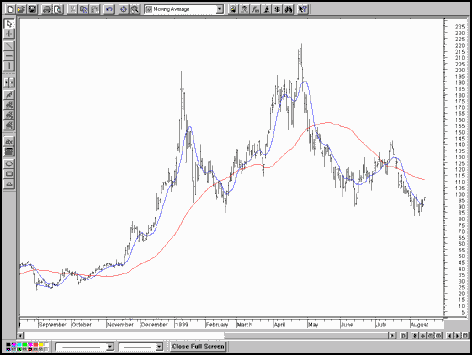Novice Traders’ Notebook
Indicators
2. Moving Averages: Periods
What two time periods are best to use in moving averages?
Unfortunately, there is no definitive answer. Like most answers to questions in technical analysis, it depends upon many factors, such as your investment or trading time frame. Generally, moving average lengths chosen by intraday traders will be shorter than those used by investors with longer holding periods.

Amazon.com
The specific market and type of trading conditions the market is in will also affect the choice of moving average length. Markets in trading ranges usually cause “whipsaw” losses for moving average systems using long time periods. This is due to the inherent lag of a moving average. The shorter the time period used for a moving average, the less the lag. However, the shorter the time period, the more responsive to price the moving average is. The figure above shows two different length MAs plotted for the daily price bars for Amazon.com. Since one of the main reasons for using moving averages in the first place is to represent the general trend of the market, without showing every price twitch, there is a fine line between too much lag or too much “noise.”
This has given rise to different methods of calculating the moving average, which must be chosen by the technician as well. Two of the more common methods are simple and exponential, with the simple method giving equal weight to each value being averaged. The exponential moving average, on the other hand, gives more weight to recent values than to older values. For more information on exponential moving averages, as well as other types of MAs, search our article archive.